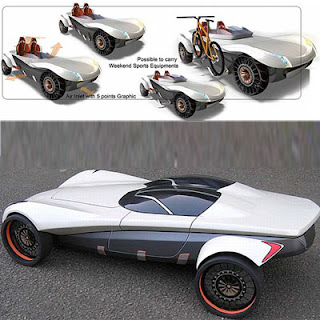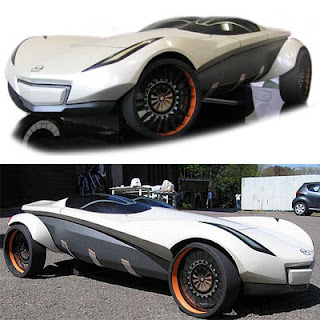
Tuesday, September 29, 2009
Wednesday, September 23, 2009
TONBO Mazda DedekDesign Concept Car
A concept car designed by DedekDesign and Mazda of Europe adds a whole new dimension to sports cars – the addition of a rack system to carry sport equipment.
The car is to be powered by hydrogen fuel cells to ensure that all that comes out of the exhaust is pure water. Just like the Rinspeed Scuba, this car too is designed to drive in water. Whenever we talk about sports cars the thing that strikes our mind first is a car with a massive engine, mind boggling speed and distinct looks that gets some heads to turn anywhere it goes.
Another innovative feature to be incorporated in this car is the use of an anti-vandal parking system that takes care of some parking woes.
Volkswagen E-Up! Concept Car "Micro-mobility in the city"
 Volkswagen is comprehensively addressing implementation of this everyday practicality. These efforts not only encompass the vehicle itself, but the entire environment around the car driver. In the city, for example, this includes the realisation that after parking the Volkswagen E-Up! Concept people will want to cover shorter distances without a car - from the job to lunch, to the fitness studio, another meeting, whatever is on the day's schedule. For these shorter trips, the Volkswagen "Micro-mobility in the city" concept team has invented clever zero-emission micro-vehicles. The Kickstep, for example, which is an ultra-compact folding scooter. And the electrically powered Microbully, a scooter that also fits easily in the Volkswagen E-Up! Concept load space. There is also the ped-tric, a folding bike with electric motors built into the wheel hubs that could also make the trip to the city aboard the Volkswagen E-Up! Concept And even the VW_1M, a large electric moped - the size of a carry-on case when not in use - that could be stowed in the Volkswagen E-Up! Concept without even needing to fold down the rear bench seat. Such micro-mobility solutions were created at the Volkswagen Design Center in Potsdam. So the E-Up! will be putting many things into motion.
Volkswagen is comprehensively addressing implementation of this everyday practicality. These efforts not only encompass the vehicle itself, but the entire environment around the car driver. In the city, for example, this includes the realisation that after parking the Volkswagen E-Up! Concept people will want to cover shorter distances without a car - from the job to lunch, to the fitness studio, another meeting, whatever is on the day's schedule. For these shorter trips, the Volkswagen "Micro-mobility in the city" concept team has invented clever zero-emission micro-vehicles. The Kickstep, for example, which is an ultra-compact folding scooter. And the electrically powered Microbully, a scooter that also fits easily in the Volkswagen E-Up! Concept load space. There is also the ped-tric, a folding bike with electric motors built into the wheel hubs that could also make the trip to the city aboard the Volkswagen E-Up! Concept And even the VW_1M, a large electric moped - the size of a carry-on case when not in use - that could be stowed in the Volkswagen E-Up! Concept without even needing to fold down the rear bench seat. Such micro-mobility solutions were created at the Volkswagen Design Center in Potsdam. So the E-Up! will be putting many things into motion.The zero-emissions concept car designed under the leadership of Dr. Ulrich Hackenberg, Member of the Board of Management, Volkswagen Brand, and Head of the Development business area, is based on modules of the New Small Family anticipated in the year 2011, but at a length of 3.19 meters it is even more compact. It also offers an innovative 3+1 seating concept.
The 135 km/h fast 3+1 seater is driven by an electric motor with a peak power output of 60 kW (continuous power: 40 kW). The motor of the front-wheel drive car, which is mounted in front, develops a maximum torque of 210 Newton-meters right from rest. The driver activates forward or reverse gear via a rotary knob in the centre console. The fact that the Volkswagen E-Up! Concept will also quite clearly offer driving enjoyment is demonstrated by a look at the car's classic 0 to 100-km/h sprint time: 11.3 seconds. The Volkswagen E-Up! Concept develops even greater responsiveness in the intermediate sprint from 0 to 50 km/h in city driving: 3.5 seconds. This dynamic performance is based first on the electric motor's excellent torque characteristic and second on the low kerb weight of the Volkswagen E-Up! Concept, which is just 1,085 kilograms.
 Lithium-ion battery: The car's low weight is quite astounding, given the fact that 240 kilograms are taken up by the lithium-ion battery. The implemented battery's energy capacity of 18 kilowatt-hours (kWh) enables driving distances of up to 130 kilometres, depending on driving style - enough for the city and the drives of most commuters. The Volkswagen E-Up! Concept will be "refueled" in the garage at home, in a parking structure or on the road at one of the future municipal recharging stations that will be enabled by chip card. Depending on the available charging infrastructure and the battery's momentary charge state, the storage battery could be charged to up to 80 percent of its total capacity within an hour.
Lithium-ion battery: The car's low weight is quite astounding, given the fact that 240 kilograms are taken up by the lithium-ion battery. The implemented battery's energy capacity of 18 kilowatt-hours (kWh) enables driving distances of up to 130 kilometres, depending on driving style - enough for the city and the drives of most commuters. The Volkswagen E-Up! Concept will be "refueled" in the garage at home, in a parking structure or on the road at one of the future municipal recharging stations that will be enabled by chip card. Depending on the available charging infrastructure and the battery's momentary charge state, the storage battery could be charged to up to 80 percent of its total capacity within an hour.If the batteries are recharged in a home garage, for example, by plugging it into a 230-Volt household outlet, this would take a maximum of five hours. Generally, off-peak night-time electric rates are very inexpensive. So refueled at night the Volkswagen E-Up! Concept could be driven 100 kilometres for just two Euros in electricity costs (about 14 Euro cents / kWh).
The batteries themselves are housed in the underbody of the Volkswagen E-Up! Concept To optimally distribute the weight of the battery system, it is housed in a special, crash-protected tray in the underbody frame. Air cooling ensures a constant heat balance within the batteries. The fans and heat exchangers needed for this are housed in the front section of the underbody. In 2013 this will become a reality for the first time.
Bugatti Galibier 16C Concept Car comfort and elegance of a modern four-door saloon
At the historic site where Ettore Bugatti once laid the cornerstone of his company, Bugatti's current president, Dr. Ing. Franz-Josef Paefgen emphasised that the Bugatti Galibier 16C is one of several concept studies with which the company is considering for the future of the Bugatti marque.
Power comes from the works 8-litre 16-cylinder motor with two-stage supercharging. It can churn out between 588kW (800hp) and 735kW (1,000hp), all of which is channeled to all four wheels using the AWD system. Standard fuel is petrol but ethanol can be used as an alternative. To stop it running away from the driver is a set of powerful carbon ceramic brakes.
The Bugatti Galibier's design masters the challenge of uniting sportiness with the comfort and elegance of a modern four-door saloon. The basic architecture picks up on the torpedo-like character of the Type 35, which was already revived in the Bugatti Veyron, and reinterprets it. With the typical Bugatti radiator grille, big round LED headlights and the clamshell running the length of the vehicle which became synonymous with the brand identity under Jean Bugatti in the Type 57, this car transports the Bugatti genes into the modern world.
 The interior reflects the elemental design of the exterior. The dash panel has been reduced to the essential; two centrally located main instruments keep even the rear passengers constantly informed of the actual speed and previous performance. Parmigiani, the Swiss maker of fine watches, created the removable Reverso Tourbillon clock for the Bugatti Galibier, which may be worn on the wrist thanks to a cleverly designed leather strap.
The interior reflects the elemental design of the exterior. The dash panel has been reduced to the essential; two centrally located main instruments keep even the rear passengers constantly informed of the actual speed and previous performance. Parmigiani, the Swiss maker of fine watches, created the removable Reverso Tourbillon clock for the Bugatti Galibier, which may be worn on the wrist thanks to a cleverly designed leather strap."Galibier" is not just the name of one of the most difficult alpine passes along the Tour de France but, in its time, was a version of the four door Type 57 unequalled in sportiness and elegance.
Monday, September 14, 2009
Subscribe to:
Comments (Atom)







